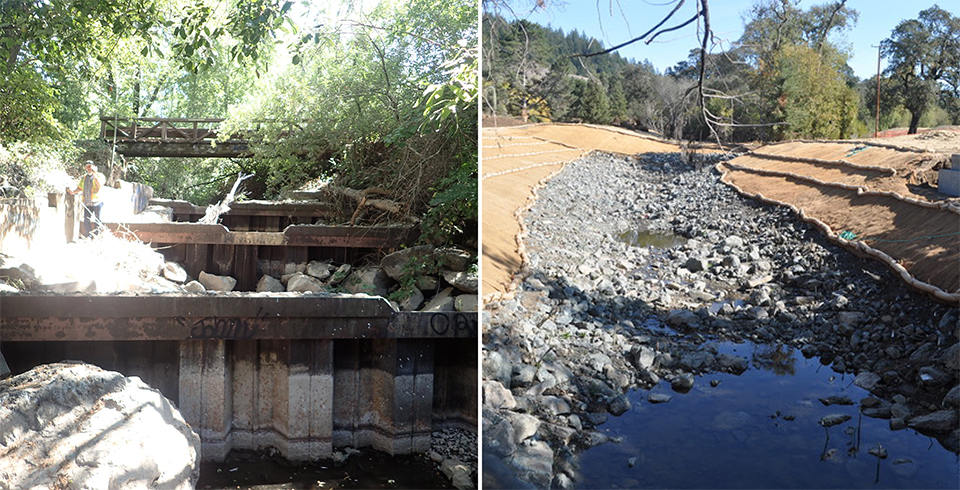 A free-flowing creek will soon replace Central California’s highest priority fish passage barrier, known as Roy’s Pools, thanks to a 20-year community restoration project that is intimately tied to the genesis of the Salmon Protection And Watershed Network, or SPAWN!
A free-flowing creek will soon replace Central California’s highest priority fish passage barrier, known as Roy’s Pools, thanks to a 20-year community restoration project that is intimately tied to the genesis of the Salmon Protection And Watershed Network, or SPAWN!
Located on the former San Geronimo Valley golf course, Roy’s Pools is a series of dam and fish ladders constructed of concrete and sheet metal that currently limits migration and creates poor habitat conditions for endangered coho salmon and other aquatic species. By removing the dam and fish ladder, SPAWN is creating and restoring approximately five acres of creek habitat with the construction of 0.25-mile long floodplain corridors along the San Geronimo Creek Watershed—one of the most important watersheds left for endangered coho salmon.
Nearly 25 years ago, SPAWN’s Executive Director Todd Steiner discovered migrating coho salmon stranded on the broken apron of Roy’s Dam that was built in the 1940s to provide a stock pond for cattle and the Roy’s family farm. To help rescue stranded salmon, citizens mobilized to relocate the struggling fish and SPAWN was born out of a grassroots effort to help the struggling fish.
To help get fish over the former Roy’s Dam, NOAA Fisheries and other partners develop designs for a series of pools, resulting in the Roy’s Pools structure we know today. As the Roy’s Pools structures aged, however, it became clear that while the adult passage problem was solved, the juvenile passage—especially for outmigrating smolts—was still a problem. Fish would become trapped in the pools on their way to the ocean and could not escape. In the summer, young fry could not migrate upstream to cooler waters and were cut off from the habitat above the pools. Stagnant water in the pools created breeding sites for mosquitoes and a home for invasive bullfrogs.
In addition to providing critical habitat for young salmon, this project will make valuable corridors for terrestrial wildlife movement and greatly increase the amount of trees for nesting birds. A larger forest of trees and riparian plants will allow more opportunities for wildlife including bobcats and deer to hunt, forage, nest, rest, and find refuge along a naturally-flowing and healthier creek.
“There is so much impressive work that goes into creating a whole new environment designed to benefit both the environment and the community,” said Director of Watershed Conservation Preston Brown. “Knowing there will be no fish barrier after so many years is exciting, and we are so grateful to all of the organizations and individuals who are working on, funding, and supporting this long-awaited project.”
When the construction and large earth-moving is complete this fall, volunteers, students and community members will help plant native trees, grasses, shrubs, and other native plants grown in SPAWN’s nursery to revegetate and stabilize the site. In total, 850 trees and stakes; 2,250 shrubs, perennials and vines; and 3,400 grasses, sedges, and rushes will be planted. In addition, 205 pounds of native grass seed will be broadcast.
The Roy’s Pools Fish Passage and Floodplain Restoration Project is a collaborative project made possible by the California Department of Fish and Wildlife Fisheries Restoration Grant Program, NOAA National Marine Fisheries Service Restoration Center, and the members and volunteers of Turtle Island Restoration Network, SPAWN’s parent organization.
Follow the latest updates on this innovative project at www.seaturtles.org/roys or find SPAWN on Facebook!




